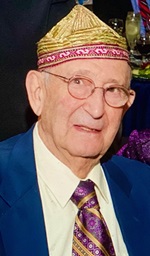Helen Aminoff

Childhood in Jerusalem
Born on January 16, 1926 in Kokand, Bukhara, now Uzbekistan, David Aminoff was the younger son of the late Bluria Davidbayeff and Abba Baruch Aminoff, and brother of the late Isaac Aminoff. The family emigrated to escape the pogroms when David was just over a year old. En route to Palestine, where his paternal Grandfather was living, his father died unexpectedly in Moscow. Nevertheless, the family continued onto Jerusalem.
Education in England
His mother passed away when David was five and, two years later, upon the death of their grandfather, David and his brother were brought to England by their paternal uncle Savi Aminoff.
With the exception of a stint in the countryside during World War Two, when he was evacuated with other children to escape the German aerial bombardments of London, David was educated in London, receiving his B.Sc. in Chemistry and Physiology with First Class Honors from Chelsea Polytechnic, University of London.
Unable to pursue a career in medicine due to the quota system, he joined the research group of the late Walter T.J. Morgan at the Lister Institute of Preventive Medicine, University of London, and received his Ph.D. in Biochemistry in 1949.
Early Career in Israel (1949-1957)
Wishing to join as pioneers in developing the new state of Israel, David turned down an invitation to work with Nobel Prize winner, Prof. T. Reichstein in Switzerland, and the two brothers immigrated to Israel. There, David became affiliated with the Israeli Red Cross, Magen David Adom (MDA), assisting in the creation and establishment of the Marcus Institute for Blood Fractionation in Jaffa, and continuing his research endeavors at the Israeli Institute of Biological Research. In 1955, the MDA sent David to Europe and the U.S. to visit blood banks and plasma fractionation centers. That led to his appointment as an exchange scientist in the laboratories of Prof. Erwin Chargaff at Columbia University, and to his fateful blind date with Helen who became his bride after a whirlwind romance.
American Research Career (1957-1999)
Their marriage and honeymoon through Europe en route to Israel were interrupted by the Suez War in 1956 and, in 1957, they returned to New York City where David became a research associate at The Public Health Research Institute of New York, Inc.
There, he developed an assay for viral and bacterial sialidases, detecting free sialic acid in the presence of the bound compound. That assay earned him the recognition of a Citation Classic.
In 1960, David joined the Rackham Arthritis Research Unit at the University of Michigan, moving to the Simpson Memorial Institute in 1962 where he served as ombudsman and basic scientist, with a joint appointment in the departments of Internal Medicine and Biological Chemistry. At the Simpson, he continued his interest in red blood cells, working on the development of a universal blood donor type and studying the mechanism for clearance of senescent erythrocytes from circulation.
In recognition of this work, David was awarded the D.Sc. degree in 1974 by the University of London.
He became a full professor in 1980, and from 1985-1991, he was a research scientist in the Institute of Gerontology, exploring further the signal for clearance of red blood cells from circulation at 120 days.
He then returned to a full appointment in the Department of Biological Chemistry pursuing his interests in collaboration with colleagues at other institutions in France and Israel.
Emeritus Years and Later Research (1999-2024)
David Aminoff retired with active emeritus status in the fall of 1999 and, until his death last year, was pursuing research using the red blood cell as a timeline to detect exposure to various toxins, including pesticides, nerve gas, etc.
In 2009, preliminary results of his work were published in the Journal of Analytical Biochemistry. His research, funded by a Translational Grant for the application of basic research to clinical applications, focused on using the red blood cell to develop biomarkers for disease, such as Hodgkin lymphoma, acute leukemia, bipolar disease, and uremia.
Most recently, his research focus was using the red blood cell to develop biomarkers for Alzheimer’s Disease. Summation of his work, until interrupted by the Covid shutdown, has been peer reviewed and accepted for publication as a Letter to the Editor in the scientific journal, Cytometry B.
In addition to his research endeavors, David served on numerous academic committees at the University of Michigan. In 1966, he volunteered to spend a summer at Tuskegee University teaching biological chemistry. He brought one of his promising students to the University of Michigan and, after graduation, she became a professor at Howard University. A member of Beth Israel Congregation for over 60 years, he served on its Education Committee and attended daily minyan weekly for many years.
Beyond the Laboratory
His loves were his family and his work. Upon his initial “retirement” in 1999, David very much enjoyed auditing classes at the University of Michigan in such subjects as the history of art and music, the history of religion, and American istory, making up for what he missed while focusing on math and science. An avid gardener (leaving the roses to Helen), David took great pleasure in creating beautiful and unique flower arrangements for which he was almost as well-known as his whiskey sours.
David Aminoff is survived by his beloved wife, Helen, his loving children Debbie (Steve Kraman), Susan and Janet, his adored grandson Seth Kraman, and cousins, nieces, great-nieces, nephews and great-nephews in the United States and Israel.
